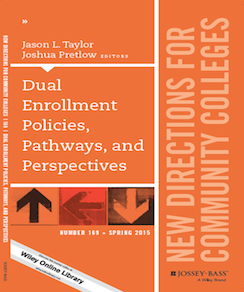There is a renewed interest in dual enrollment (also known as dual credit or concurrent enrollment) among many educators and policymakers around the country. Dual enrollment offers high school students a chance to experience college and is often promoted to save students money and accelerate their time to degree. It also requires collaboration between secondary and postsecondary educators which can support P-16 alignment efforts. There is also accumulating evidence about the impact of dual enrollment on important outcomes such as high school graduation, college enrollment, and college retention and completion. It is for these reasons, and many others, that dual enrollment is increasingly capturing the attention of educators, policymakers, and parents and students.
These topics and many others are explored in a recently released volume of New Directions for Community Colleges (NDCC) that was co-edited by myself and Josh Pretlow. We framed the volume around three related dimensions: policies, pathways, and perspectives. In the first portion of the volume, chapter authors explore the intricacies of state policies and how state policies shape and sometimes constrain local dual enrollment programs. In the second part, the chapters examine how dual enrollment programs are designed as pathways for various student groups, including CTE students and increasingly underserved students in the form of Early and Middle College High Schools. The authors in the last portion of the volume provide the perspectives of dual enrollment stakeholders such as students, high school faculty and staff, and faculty teaching dual enrollment courses. The volume concludes with a chapter describing the emerging accreditation standards and process of the National Alliance for Concurrent Enrollment Partnerships (NACEP) and a thought piece by Melinda Karp on the relationship between dual enrollment and the college completion agenda.
We know from national data that community colleges are more likely than other postsecondary sectors to provide dual enrollment programs, and the number of students participating in dual enrollment has increased in the past decade. Community colleges are really leading many dual enrollment efforts around the nation, and this volume explores many dimensions of dual enrollment policy and practice. I encourage you to peruse the volume and share your questions and thoughts below!





Leave a comment